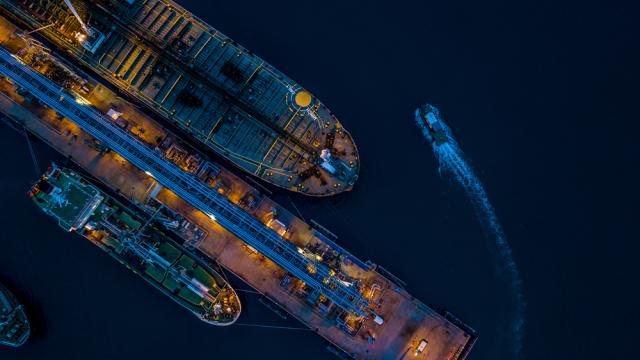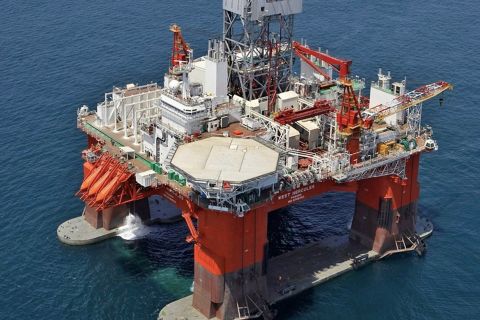
Companies are now laying the groundwork to sharply increase overseas crude oil sales. (Source: Avigator Thailand/Shutterstock.com)
Oil was more than $100 per barrel in 2008 when the pipeline company Enterprise Products Partners announced the Texas Offshore Port System. The $1.8 billion “Tops” project would have unloaded foreign crude oil from supertankers and fed it to a country desperate for more.
Tops was never built. But Enterprise is now back with a project spelt in reverse. The Sea Port Oil Terminal—“Spot”—would be able to load a supertanker a day with U.S. oil for export from the Texas coast.
Enterprise’s application for a federal permit to build Spot, filed last week, reflects more than executives’ sense of humor. It shows how the U.S. has changed over the past decade from being the world’s biggest importer of oil to a leading supplier. Next year it will become a net energy exporter, government analysts predict, thanks to surging oil and gas production.
Companies are now laying the groundwork to sharply increase overseas crude oil sales. They are expanding docks, dredging channels to make them deeper and proposing offshore loading stations in the Gulf of Mexico to lure the largest supertankers. The black gold rush comes three years after lawmakers allowed unrestricted crude oil exports. Shipments have quadrupled to 2.4 million barrels per day (MMbbl/d), and oil executives foresee a further doubling of exports.
Coastal infrastructure is critical to that growth. The U.S. today has the capacity to export 8 MMbbl/d of crude from the Gulf coast, and another eight projects under development would raise it above 12 MMbbl/d, according to Lipow Oil Associates, a Houston-based consultancy.
The prospect of overcapacity has sparked a race to be first.
“We believe that only three get built,” says Tom Ramsey, CEO of Jupiter Energy Group. He hopes his project, a 1 MMbbl/d terminal off Brownsville, Texas, will be one of them.
The prize is the ability to fully load a very large crude carrier (VLCC), a supertanker big enough to transport oil profitably to Asia. The channels at the ports of Corpus Christi and Houston are currently too shallow to fill a VLCC without it getting stuck. Partially loading VLCCs adds time and 50-75 cents per barrel to the cost of transport as they must be topped up offshore by smaller vessels, according to a report from Katherine Spector of Columbia University’s Center on Global Energy Policy.
Jockeying among developers has become intense. A subsidiary of Swiss-based commodities trader Trafigura, for example, has sought regulatory approval to build a VLCC loading terminal at a buoy about 15 miles offshore near Corpus Christi.
The Corpus Christi port authority has begun its own $409 million dredging project to allow larger tankers to sail in and has proposed a $1 billion new oil export terminal with Carlyle Group, the private equity investor, which would further deepen the channel to enable VLCCs to depart full.
The port authority has asked federal regulators to deny the company’s application. Its lawyer invoked a 12-year-old criminal case against Trafigura and its recent entanglement with Brazil’s biggest corruption case, known as Operation Car Wash.
“These guys aren’t Boy Scouts,” said Sean Strawbridge, the port’s chief executive.
The port has threatened to sue the U.S. Maritime Administration if Trafigura’s project is permitted to proceed. In September, the port hired lobbyists in the Texas state capital to work on “offshore oil terminals,” records showed. “The governor can veto it for any reason or no reason at all,” Strawbridge said.
Trafigura declined to comment on the port’s claims about legal matters. With respect to Brazil, which in December charged two former Trafigura executives with bribery, the company referred to an earlier statement saying that it has a “zero tolerance policy on bribery and corruption.”
“We think a deepwater port is the most efficient, effective, safe way to get the Texas producers’ oil to market,” said Corey Prologo, Trafigura’s director of North American oil trading.
The export terminals proposed across Texas and Louisiana would handle a quickening flow of American oil. After cutting back during the recent oil price rout, drillers in shale regions have propelled U.S. crude production to nearly 12 MMbbl/d, more than Russia or Saudi Arabia.
Output might have been higher but for a shortage of pipelines in inland basins. As new pipelines open, oil could instead back up in coastal terminals without further exports. In Houston, energy shippers are worried that a new fleet of giant container vessels will crowd their tankers and barges and have formed a group called the Coalition for a Fair and Open Port to protect access.
Offshore terminals skirt port congestion by loading crude from underwater pipelines on to supertankers moored at sea. Only one terminal can currently load a 2 MMbbl VLCC: the Louisiana Offshore Oil Port (Loop), which was modified last year to handle exports as well as imports. In December, three full VLCCs left Loop in a single week.
More terminals are in the race. The same day Enterprise submitted paperwork to build Spot, a joint venture named Texas Colt filed its own application to build a competing offshore facility outside Freeport, Texas.
Buckeye GP, a midstream energy company which handles crude exports through an onshore terminal in Corpus Christi, is now developing another.
“The U.S. is going to play an increasingly important role in global energy supply,” said Khalid Muslih, executive vice president at the company.
Recommended Reading
US Drillers Add Oil, Gas Rigs for Second Week in a Row
2024-01-26 - The oil and gas rig count, an early indicator of future output, rose by one to 621 in the week to Jan. 26.
Second Light Oil Discovery in Mopane-1X Well
2024-01-26 - Galp Energia's Avo-2 target in the Mopane-1X well offshore Namibia delivers second significant column of light oil.
E&P Highlights: Jan. 29, 2024
2024-01-29 - Here’s a roundup of the latest E&P headlines, including activity at the Ichthys Field offshore Australia and new contract awards.
Seadrill Awarded $97.5 Million in Drillship Contracts
2024-01-30 - Seadrill will also resume management services for its West Auriga drillship earlier than anticipated.
Oceaneering Won $200MM in Manufactured Products Contracts in Q4 2023
2024-02-05 - The revenues from Oceaneering International’s manufactured products contracts range in value from less than $10 million to greater than $100 million.




